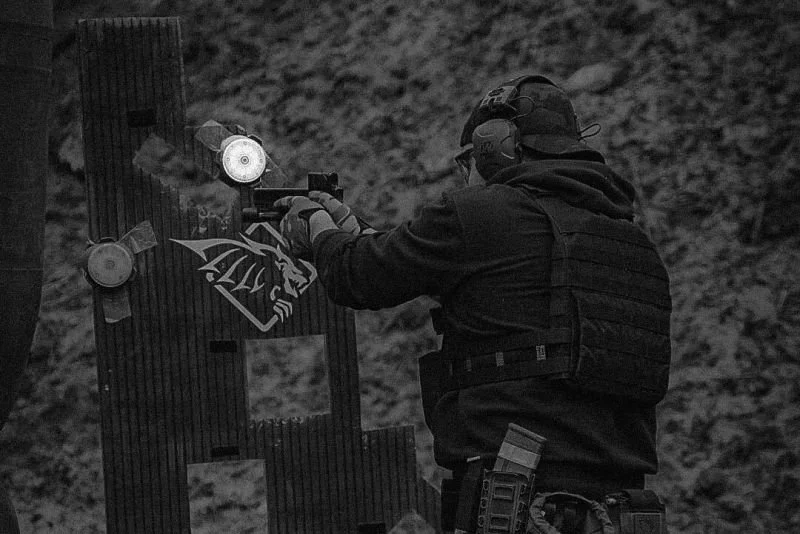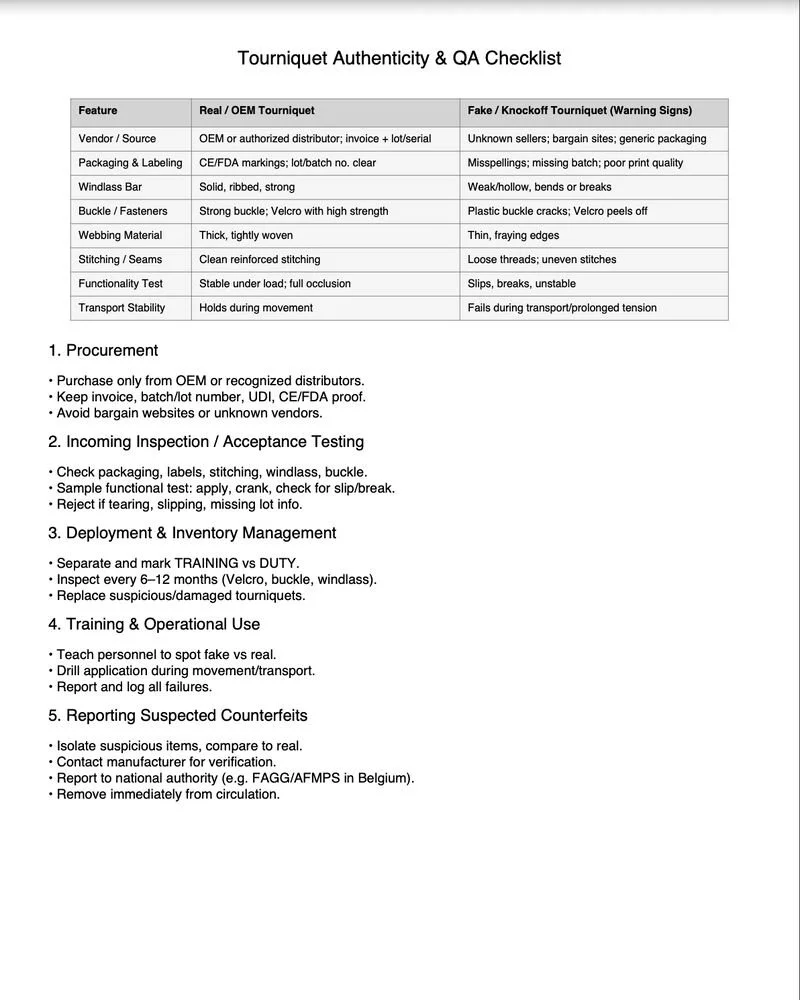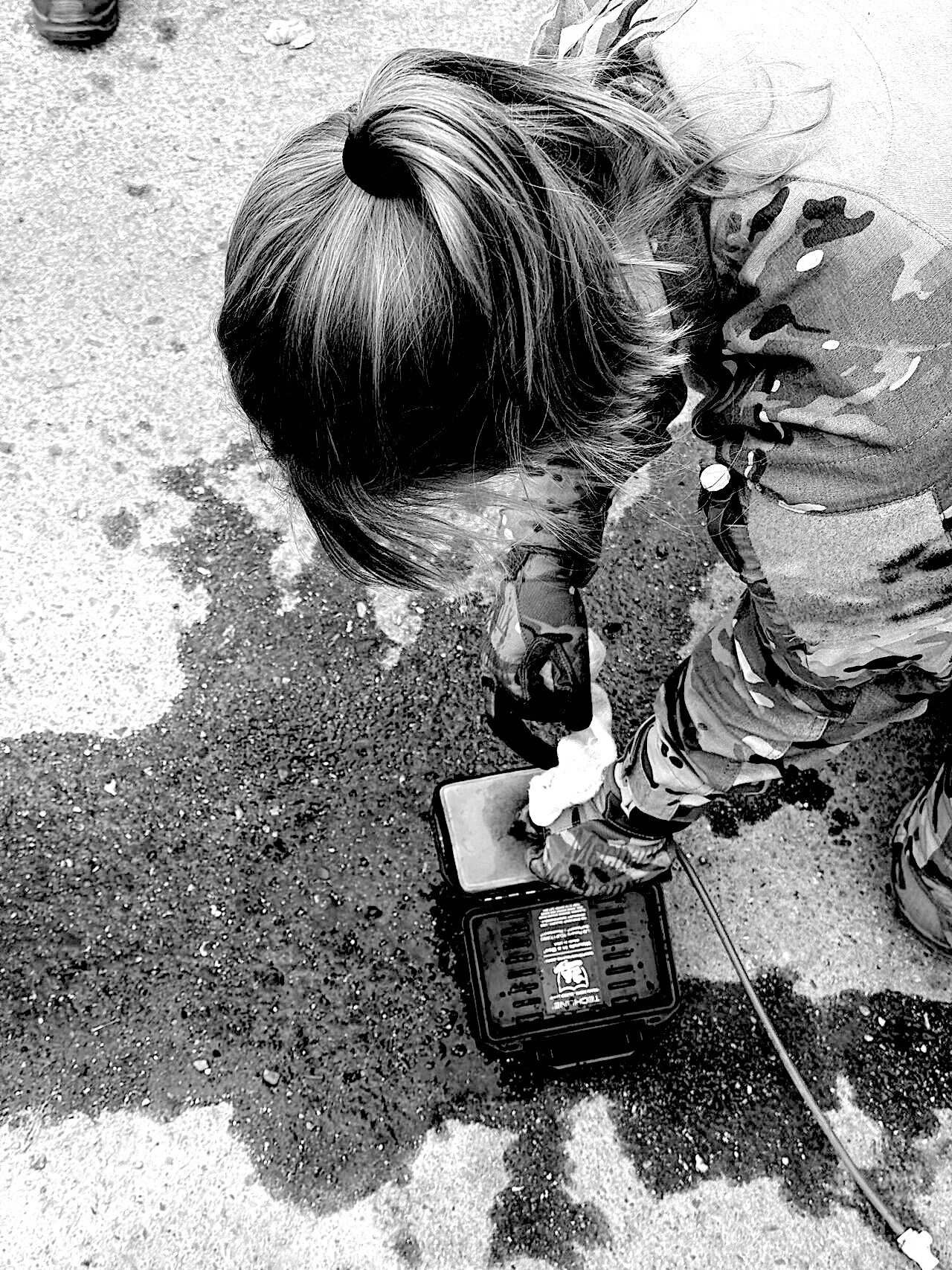Visuele prikkels in tactische training: de volgende stap naar realistische besluitvorming onder druk.
👁️🗨️ In elke interventie of operationele context beslis je op basis van wat je ziet.
Nog vóór je hersenen een keuze kunnen formuleren, heeft je visuele systeem al een interpretatie gemaakt van dreiging, beweging of intentie.
Onder stress, met beperkte tijd, adrenaline en vermoeidheid, bepaalt de kwaliteit van je visuele input rechtstreeks de kwaliteit van je beslissing.
Daarom evolueren moderne trainingsmethodes richting visueel-cognitieve stimulatie.
Door gebruik te maken van systemen zoals BlazePods, FitLights of de Vector Ball, leer je cursisten reageren op visuele signalen in plaats van op vaste, vooraf bekende patronen.
De kleur of lichtflits wordt dan een beslissingsmoment: engage, observe, de-escalate of hold.
Zo train je niet enkel spiergeheugen, maar vooral het brein – het vermogen om in fracties van seconden te onderscheiden wat echt telt.
Wetenschappelijk onderzoek én praktijkervaring tonen aan dat visuele prikkels:
🔹 de reactiesnelheid en dreigingsdiscriminatie verbeteren,
🔹 perifere aandacht en hand-oogcoördinatie versterken,
🔹 en vooral het aantal beslissingsfouten onder stress aanzienlijk verlagen.
Deze aanpak sluit perfect aan bij realistische Law Enforcement en militaire trainingsdynamieken: korte reactietijden, hoge cognitieve belasting en de noodzaak tot foutloze besluitvorming.
Zoals KHIMAIRA STRATEGY TACTICS (foto) terecht aanhaalt:
“L’œil est un muscle, et l’entraîner, c’est affûter la décision.”
De toekomst van tactische training ligt niet in méér munitie, maar in betere prikkels.
Train het oog, train het brein, en de rest volgt vanzelf.
💡 Zelf heb ik recent een set BlazePods aangeschaft bij EVOLVE Training Group, om deze methode verder te integreren in mijn eigen trainingsmodules binnen Ex Arma Scientia.
Het doel: de koppeling tussen visuele prikkel, cognitieve beslissing en tactische uitvoering nog verder verfijnen, in lijn met hoe echte situaties zich ontwikkelen.
Verhoogde jihadistische dreiging in Europa: een harde realiteit
De voorbije weken zagen we opnieuw een reeks alarmerende incidenten die aantonen dat de dreiging van IS/Daesh-inspiratie in Europa verre van verdwenen is. Integendeel… ze evolueert, past zich aan, en blijft dodelijk relevant.
🇧🇪 België: In Antwerpen werd een aanslag op premier Bart De Wever en andere politieke leiders verijdeld.
Tijdens huiszoekingen werden o.a. een geïmproviseerd explosief, stalen kogels en plannen om een drone te bewapenen aangetroffen. De federale procureur bevestigde dat het ging om een “jihadistisch geïnspireerde” cel, die mogelijk dezelfde dag nog wou toeslaan.
🇬🇧 Verenigd Koninkrijk: In Manchester vond een dodelijke aanval plaats tijdens Yom Kippur, waarbij de dader riep: “Ik heb twee Joden gedood in naam van de Islamitische Staat.”
Daarnaast staan twee mannen terecht voor het plannen van een massale aanslag op Joodse gemeenschappen, na maandenlange voorbereiding en digitale infiltratie van religieuze Facebook-groepen.
Deze voorbeelden illustreren een duidelijke trend:
⚙️ Lone actors & kleine cellen
🕹️ Gebruik van drones, IED’s en 3D-technologie
💻 Digitale rekrutering en doelwitselectie via sociale media
🎯 Focus op symbolische doelen: politieke en religieuze
🛡️ Wat betekent dit voor ons, in Europa?
De dreiging verschuift van georganiseerde groeperingen naar gedecentraliseerde, ideologisch gedreven individuen.
Dat vraagt om:
➡️ Intelligente samenwerking tussen veiligheidsdiensten
➡️ Preventie en digitale weerbaarheid
➡️ Realistische training & voorbereiding op hybride dreigingsscenario’s
📍 De strijd tegen terrorisme is niet enkel militair of politioneel.
Ze is ook sociaal, digitaal en ideologisch.
En ze vraagt voortdurende waakzaamheid, niet enkel bij de overheid maar ook binnen de private en maatschappelijke sector.
Het gevaar van valse tourniquets!
🌍 Tijdens mijn recente inzet in Irak kreeg ik de kans om van dichtbij enkele zogenaamde “professionele” medische interventierugzakken te bekijken.
Wat aanvankelijk oogde als goed uitgeruste en betrouwbare uitrusting, bleek bij nadere inspectie een serieuze ontgoocheling…
In deze rugzakken trof ik valse CAT-type tourniquets aan (zie foto).
Ze lijken bedrieglijk echt, maar in werkelijkheid falen ze vaak juist op het moment dat je ze het hardst nodig hebt.
🚨 De gevaren van zulke namaak zijn enorm:
❌ Windlass die breekt onder torsie → geen arteriële afsluiting
❌ Gespen en stiksels die het begeven tijdens transport
❌ Onvoldoende druk → veneuze congestie i.p.v. bloedingstilstand
❌ Een vals gevoel van zekerheid voor de operator
➡️ Het resultaat? Het slachtoffer blijft bloeden, de levensreddende interventie mislukt, en kostbare minuten gaan verloren. In een conflict- of operationele omgeving is dit geen klein detail – dit gaat letterlijk over leven of dood.
💡 Eén enkel vals tourniquet in een rugzak kan het verschil betekenen tussen redding en tragedie.
Daarom mijn oproep: diensten, NGO’s, opleidingscentra en operatoren moeten waakzaam blijven.
✅ Koop uitsluitend via erkende leveranciers zoals bijvoorbeeld LS INNOVENTA bv
✅ Controleer lotnummers, verpakking en afwerking
✅ Voer steekproefcontroles en functionaliteitstests uit
✅ Train personeel om namaak te herkennen en direct te rapporteren
📑 Om dit concreet te ondersteunen voeg ik mijn Tourniquet Authenticity & QA Checklist toe, een praktische gids met herkenningspunten en kwaliteitscontroles die meteen toepasbaar is in het veld.
Het leven van collega’s en slachtoffers hangt soms af van dit ene stukje nylon en plastic.
Laten we er samen voor zorgen dat wanneer iemand in een noodgeval naar een tourniquet grijpt, dit ook een echte en betrouwbare is
Backpack Drones: Tactical Integration Based on the Ukrainian Example
In February 2022, Ukrainian forces deployed a commercially available DJI Mavic drone over Irpin. Initially referred to as a recreational “wedding drone,” this system quickly became a standard reconnaissance asset in trench warfare operations.
Observation-to-Impact Acceleration
Using the Kropyva application, real-time visual feeds are integrated into digital fire coordination systems. This reduces the time between target detection and engagement to under one minute. Counter-battery responses can be initiated within 30 seconds. The reduced cycle time explains the operational preference for low-cost multirotor drones over manned reconnaissance platforms.
Thermal Imaging for 24/7 Surveillance
Thermal sensors provide constant situational awareness. These systems detect heat signatures, identify concealed personnel, and support both offensive and defensive positioning. As a result, Ukrainian training centers now include dedicated thermal surveillance instruction in UAV curricula.
Low-Cost Precision Strike
Commercial racing drone frames are repurposed for First-Person-View (FPV) strike missions. These platforms are equipped with an explosive payload, camera, and control headset, and are capable of neutralizing armored or artillery targets at close range. Production costs range from several hundred to a few thousand USD. Additionally, loitering munitions with fixed wings operate at higher altitudes, engaging high-value targets such as radar systems or command infrastructure.
Operational Constraints for Opposing Forces
Persistent drone activity requires enemy units to adopt continuous camouflage and dispersion tactics. Concentrated equipment movements are quickly identified and targeted. This disrupts operational tempo and imposes additional logistical burdens.
Cost-Effectiveness and Scalability
An FPV drone costing approximately $1,000 can deliver comparable operational effects to a Javelin missile priced over $100,000, without exposing the operator to direct risk. This cost-performance asymmetry aligns with Ukraine’s strategic emphasis on scalable production. According to the Ministry of Strategic Industries, up to 3 million drones per year can be manufactured.
Institutional Integration
In 2024, Ukraine established the Uncrewed System Forces, the first military branch solely dedicated to uncrewed aerial and ground systems. This reorganization reduced approval cycles for new equipment from over two years to six weeks. Concurrently, training institutions such as Victory Drones and Dronarium have certified thousands of operators in UAV deployment, thermal observation, and night operations.
Recommendations for Operational Environments
• Utilize Commercial-Off-the-Shelf (COTS) Equipment
Immediate availability and cost efficiency outweigh delayed acquisition of specialized military systems.
• Prioritize Human-System Training
The effectiveness of the platform is dependent on the skill of its operator.
• Shorten Innovation Timelines
Deployment of viable concepts must occur within operationally relevant timeframes.
• Evaluate by Cost-Per-Effect
Tactical tools should be assessed based on operational impact per monetary unit, not individual price.
Conclusion
Drones deployed from backpacks now function as an organic extension of ground forces, offering reconnaissance, precision engagement, and 24-hour observation capabilities. Integration of commercial drones, supported by structured training and responsive logistics, constitutes a scalable and effective component of contemporary tactical operations.
Why CBRN Training Is Essential — From Theory to Survival
In today’s complex security environment, threats are no longer limited to conventional attacks. CBRN incidents — Chemical, Biological, Radiological, and Nuclear — are silent, invisible, and often misunderstood by those untrained.
This is why structured, scenario-based CBRN training is not just a requirement — it is a mission-critical skillset.
Why is CBRN training vital?
• CBRN and Toxic Industrial Material (TIM) incidents demand an immediate, error-free response — there’s no time for hesitation or confusion.
• Past events like the chemical train disaster in Wetteren (Belgium) or the Fukushima nuclear incident highlight that CBRN is not limited to the battlefield.
• Early symptoms of chemical or biological exposure are often subtle — but can escalate fatally in minutes.
• A single operator failing a 9-second gas mask drill, a filter change, or a buddy check could jeopardize an entire team.
• Deployed personnel must master self-aid and buddy-aid techniques under extreme physical and psychological pressure.
At EX ARMA SCIENTIA, we integrate the core elements of the CBRN syllabus into our applied tactical modules:
✔️ The 9-second gas mask drill
✔️ Proper use of DUODOTE, DOUBLEPEN, and DIAZEPAM auto-injectors
✔️ Immediate skin decontamination using RSDL and powder gloves
✔️ Identification and classification of CBRN agents through visual cues
✔️ Stress inoculation drills incorporating fatigue, movement, and decision-making
✔️ Threat level understanding and IPEC (Individual Protective Equipment Code) usage
✔️ Full equipment familiarity including 3rd Gen CBRN suits and SOR/T dosimeters
CBRN is not science fiction — it is a harsh reality in modern conflict, terrorism, and industrial failure.
All personnel deployed in operational theaters must be ready — not just with gear, but with conditioned reflexes.
Drills build confidence. Training hardens instinct. In CBRN scenarios, that difference can mean life or death.
Prepare. Repeat. Understand. React.
The Importance of Regular Recertification in Tactical Emergency Casualty Care (TECC)
In a high-risk, urban environment like Brussels, Tactical Emergency Casualty Care (TECC) isn’t a luxury, it’s a necessity. TECC forms the backbone of medical response in tactical operations and critical incidents, where speed, efficiency, and skill quite literally make the difference between life and death.
That’s why organizing regular recertification sessions is not an optional extra, but an essential part of every operator’s preparation and readiness.
These sessions aren’t just about refreshing knowledge they are about reinforcing fundamental skills: stopping major bleeding, managing airways, and recognizing respiratory threats. By consistently practicing these interventions, we condition not only ourselves but our teammates. Under stress, we don’t rise to the level of our expectations we fall to the level of our training.
In TECC training, we place particular emphasis on the first three components of the MARCH protocol:
M – Massive hemorrhage
A – Airway
R – Respirations
These are responsible for the vast majority of preventable deaths. Failure to act quickly in these phases often results in lost seconds and lost lives. In an urban setting, where proximity to hospitals does not guarantee rapid care, the first minutes are critical.
Recertification reinforces the mindset of the tactical first responder: rapid assessment, correct intervention, and staying mentally engaged under pressure.
Because TECC is not just medical training it’s tactical survival.
Keep training. Keep repeating. Stay ready.
Low / No Light Shooting – Practical Considerations for Training
FBI statistics indicate that most lethal encounters occur at night, in low or no light, with an average of three shots fired in under three seconds. Despite this, the majority of training takes place in daylight or in well-lit environments, which creates a gap between real-world conditions and training settings.
Understanding light and darkness is essential. Various forms of light—direct, indirect, ambient, reflected, and natural—can significantly influence visual perception and target identification. Proper training under these conditions allows for better tactical decision-making and threat management.
Initial training should include theoretical modules that explain how lighting conditions affect both visibility and detectability. This foundation supports the practical application of low-light shooting techniques.
Flashlights play a critical role in low-light environments. When used in combination with a firearm, a flashlight provides not only illumination but also a tactical advantage. It helps in identifying threats and may temporarily disorient an aggressor.
Common handheld flashlight shooting techniques include:
One-handed techniques : FBI, Neck Index, …
Two-handed techniques : Harris, Surefire, …
Selection of the appropriate technique depends on individual preference, equipment, and operational context.
Tips for one-handed shooting include:
Slight inward cant of the firearm for skeletal alignment
Front-to-back grip pressure for control
Directing the muzzle steadily toward the target
Training in low or no light should be a regular part of firearms proficiency development. It prepares individuals for realistic conditions and minimizes performance gaps during actual incidents.
The Importance of TCCC in Annual Operational Readiness Training in the Military
Tactical Combat Casualty Care (TCCC) is a vital component of annual operational readiness training within the military. In operational environments where every second counts, the right medical knowledge and rapid intervention can mean the difference between life and death. It is therefore essential that military personnel are not only capable of treating themselves but are also able to condition and assist their teammates in tactical situations, ensuring the highest chance of survival until they reach the medical chain for further care.
TCCC specifically focuses on providing medical care under hostile conditions, where standard procedures are often not possible. The training is structured around three phases: Care Under Fire, Tactical Field Care, and Tactical Evacuation Care.
• Care Under Fire teaches how to perform lifesaving interventions under direct enemy fire, such as applying a tourniquet to stop life-threatening bleeding.
• Tactical Field Care focuses on the stabilization of casualties once the tactical situation allows, including airway management, treating shock, and controlling injuries.
• Tactical Evacuation Care covers the safe and efficient transport of casualties to higher levels of medical care.
By training TCCC annually, we ensure that every soldier is prepared for critical situations and capable of taking effective action under pressure. This not only increases individual survivability but also enhances team resilience and directly contributes to the unit’s operational effectiveness.
In combat, you cannot rely solely on rear medical support the first minutes are often decisive. That’s why mastering TCCC is not an option, but a necessity for every operational soldier.










